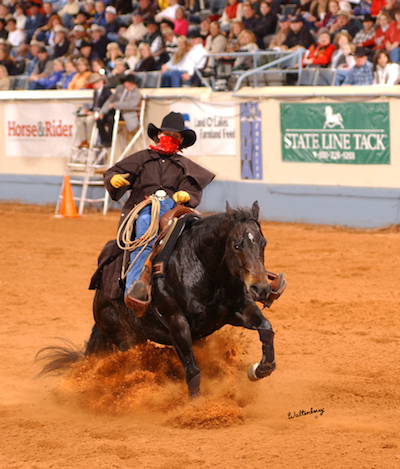When emotions are high, logic is low.
If I had known that, 20 years ago, before walking into the arena, maybe there would have been a happy ending.
But there was not.
That night, I would trot into a sold out coliseum, with over 5,000 people watching. I’d never been in front of a crowd like that.
And I was about to do something that had never been done before by any rider in the history of reining.
Knowing all this made it easy for me to dismiss my churning stomach and my shallow breathing, which were symptoms of my emotional state.
I distracted myself with grooming, cleaning the stall and listening to the music I would ride to later that night.
I was tense, my breathing shallow.
My body was a walking contradiction: shaky with energy…but I kept yawning like I could go to sleep.
I sipped tiny amounts of water.
I couldn’t even think about food.
I was stressed to the red line…but I was pushing it all down.
Looking back, it’s clear to me, the price I was paying for pretending.
In my defense, I didn’t know any better.
I didn’t know that distracting myself was causing the tension to grow.
I didn’t know that pushing my emotions down was costing me energy.
And I didn’t connect the dots between what was going on in my body, and what was about to happen with my horse.
In hindsight, my mistake is obvious.
Bridle-less riding represents a high level of communication between horse and rider.
It’s a lovely sentence to read…but the truth of it is a double-edged sword.
Developing a cue system that doesn’t rely on the reins, requires transferring the communication to the riders’ legs, body, and voice.
Pro tip: If you move all your cues to your horse into your body, be sure YOU stay present inside your own body.
I was 80% in my head and 20% in my body.
I thought I was fully present, but I was more like a distracted driver operating a vehicle.
 At home, my cue system was solid.
At home, my cue system was solid.
There were three cues I would use that night for three related maneuvers; stop and stand, stop and back, stop and roll-back.
All involved cuing the stop with my seat and legs, with a follow-up cue that triggered either the stand, back up or roll back.
The problem was in my body, which was part of my follow-up cue.
At home, she would have first read my leg cue and then looked to my body for the follow-up cue.
But at the show, my body was full of tension.
My plan was to trot in, stop, stand…and then begin my pattern.
She clearly read the stop cue…but then couldn’t make out the end of the sentence.
So she guessed.
That’s what helpful horses do.
When the rider is unclear, the horse will fill in the blank.
I intended to stand but she guessed roll-back.
Any shred of focus I did have…disappeared.
The last three minutes of that ride felt like they passed in three seconds.
I didn’t recover mentally, and I didn’t do all the required maneuvers.
Some lessons are learned the hard way, and that night packed a punch.
All those fears, thoughts, and emotions that I was pushing down left my body tense and ridged.
Can Can Lena wasn’t phased by the crowd, or the loud music…but she was confused by the way my body felt.
It turns out that in order to have a high level of communication with your horse, it is best to have a high level of communication with yourself.
Particularly between your mind and your body.
It was devastating.
Every hidden fear I had pushed down, jumped to the surface.
Every mean thought felt justified.
Every doubt felt confirmed.
Emotions are not a problem.
Pretending you don’t have hopes, dreams, fears, and the emotions that come with those…can be a huge problem.
Especially if you think you’ll be hiding those emotions from your horse without it impacting your communication.
When I think back to that experience 20 years ago, I can clearly see it was a turning point for me.
It was an opportunity wrapped in pain and disappointment.
There was no happy ending that night, that week, or even that month.
But there was a glimmer of hope: I was consistently able to do this ride at home, and I was determined to understand what I was doing differently.
During the next seven days, I’m teaching four separate calls that are totally free to attend.
I’ll be talking about the lessons I’ve learn and answering your questions live.
To learn more, click here. Registration is required.
1 Comments
Leave a Comment

FREE PDF DOWNLOAD
WHY IS MY HORSE...?
100% Private - 0% Spam
No one taught you the skills you need to work through these things.
Riders often encounter self-doubt, fear, anxiety, frustration, and other challenging emotions at the barn. The emotions coursing through your body can add clarity, or can make your cues indistinguishable for your horse.
Learning these skills and begin communicating clearly with your horse.
Click here to learn more.

Hello Stacy,
I have so admired your skills for many years, and have met you at one on the Equine Affairs many years ago. I am retired and own a well trained and smart reining Quarter horse. I have decided to have some fun and have started working on bridleless riding. I am using the first video that you made many years ago as my guide. My question is: have you made an updated bridleless riding video and if so is it available?
Also, do you travel and put on clinics any longer?